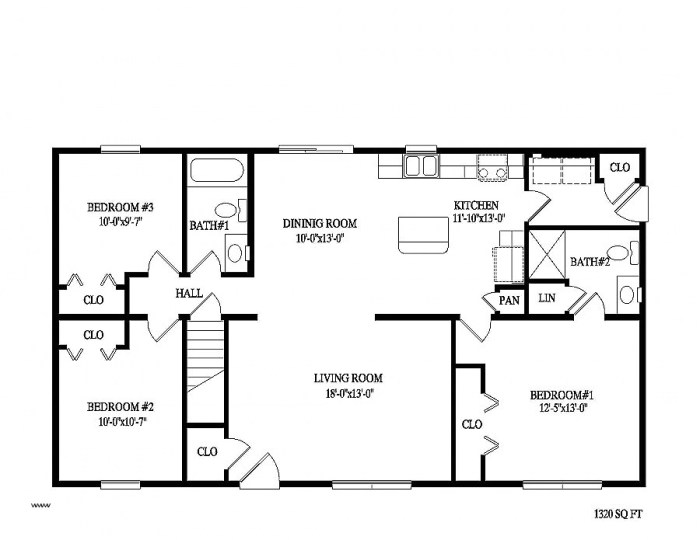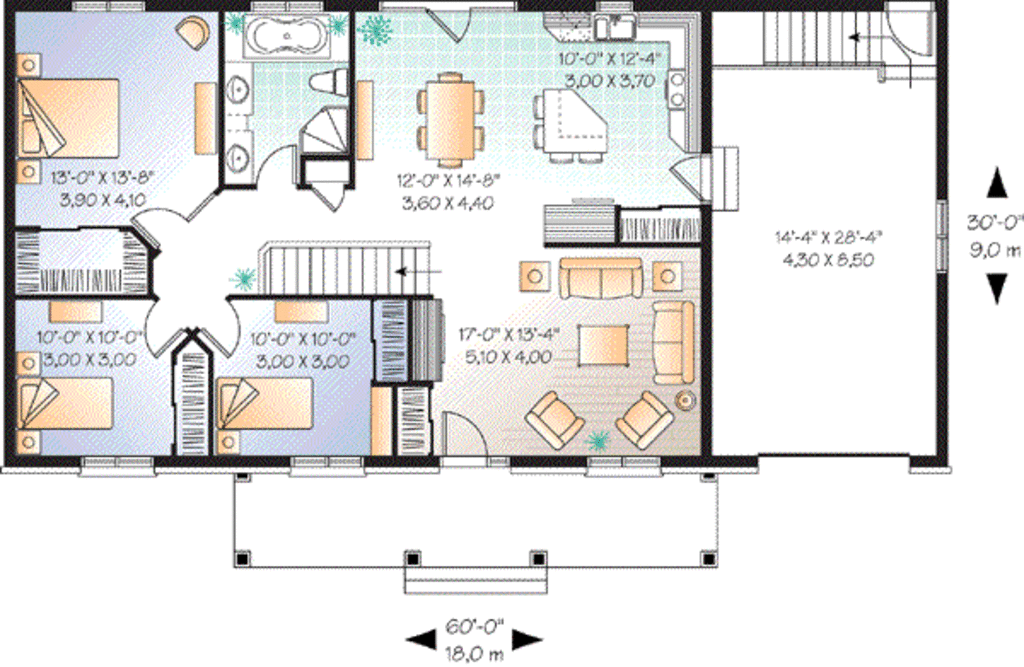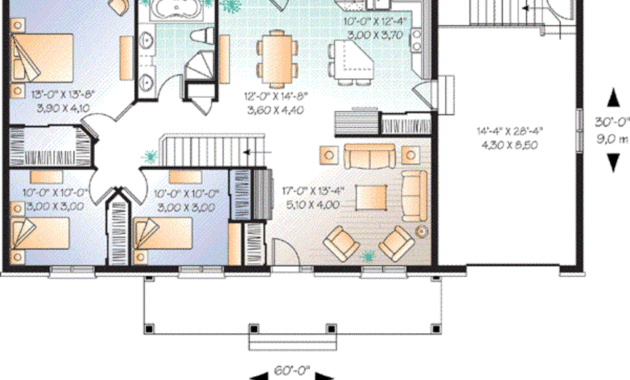1350 sq ft house interior design presents a unique opportunity to create a comfortable and stylish home without feeling cramped. This size allows for a balance between functionality and aesthetics, enabling you to incorporate various design elements and create a space that reflects your personality.
Whether you prefer a modern minimalist aesthetic or a cozy traditional style, a 1350 sq ft house offers ample space to experiment with different design ideas and create a truly personalized living environment.
This guide will explore key aspects of designing a 1350 sq ft house, from understanding the layout and flow to selecting furniture and incorporating smart home features. We’ll delve into the importance of creating a cohesive color palette, incorporating textures and patterns, and defining a style that reflects your personal preferences.
We’ll also discuss the role of lighting and natural light in creating a welcoming atmosphere, and how to utilize space effectively to maximize functionality and comfort.
Lighting and Natural Light

In a 1350 sq ft house, natural light is a crucial element for creating a bright, airy, and inviting atmosphere. It plays a vital role in enhancing the overall ambiance and functionality of the space.
Designing lighting schemes for different areas of your home involves a careful consideration of both natural and artificial light sources. The goal is to achieve a balanced and harmonious lighting environment that complements the architectural features and reflects the desired mood and functionality of each room.
Designing Lighting Schemes
A well-designed lighting scheme involves a strategic blend of natural and artificial light sources. It’s essential to consider the following aspects:
- Natural Light Maximization:Utilize large windows, skylights, and glass doors to allow maximum natural light penetration. Consider using light-colored walls and furniture to reflect light effectively.
- Artificial Light for Different Areas:
- Living Room:Employ a combination of ambient, task, and accent lighting. Ambient lighting provides overall illumination, while task lighting focuses on specific areas like reading nooks. Accent lighting highlights artwork or architectural features.
- Kitchen:Prioritize task lighting for countertops and work areas. Under-cabinet lighting, pendant lights, and recessed lighting are effective choices. Ambient lighting is essential for general illumination.
- Bedroom:Create a relaxing and inviting atmosphere with soft ambient lighting. Consider using bedside lamps, dimmer switches, and warm-toned bulbs. Task lighting can be incorporated for reading or working areas.
- Bathroom:Ensure adequate task lighting for mirrors and vanities. Use a combination of recessed lighting, vanity lights, and ambient lighting to create a functional and spa-like environment.
- Lighting Control:Implement dimmers, switches, and remote controls to adjust lighting levels according to your needs and preferences.
- Energy Efficiency:Opt for energy-efficient LED bulbs and fixtures to reduce energy consumption and save on electricity bills.
Creating a Balanced and Inviting Atmosphere
The right lighting can significantly influence the mood and ambiance of a space. To create a balanced and inviting atmosphere, consider the following:
- Warm vs. Cool Tones:Warm-toned lights (yellowish hues) create a cozy and inviting atmosphere, while cool-toned lights (bluish hues) are more stimulating and energizing. Use warm tones in living areas and bedrooms, and cool tones in kitchens and workspaces.
- Layered Lighting:Combining different types of lighting, such as ambient, task, and accent lighting, creates depth and visual interest. This approach allows you to adjust the lighting levels according to the time of day and activity.
- Dimming and Control:Dimmers and switches allow you to adjust lighting levels to create different moods and atmospheres. For example, dimming the lights in the evening can create a relaxing ambiance for socializing or reading.
Adding Texture and Patterns

Texture and patterns play a vital role in creating a visually appealing and inviting ambiance within a home. They add depth, interest, and personality to the interior design, enhancing the overall aesthetic appeal. By strategically incorporating textures and patterns, you can transform a space from ordinary to extraordinary.
Impact of Texture and Pattern on Ambiance
Texture and pattern significantly influence the overall ambiance of a space. They create visual interest and add depth to the design, making it more engaging and dynamic.
Designing a 1350 sq ft house allows for ample space to play with, but even with that size, it’s important to optimize every inch. You can find inspiration from 1 bhk small house interior design to learn how to maximize space, especially when it comes to creating functional and visually appealing layouts.
These smaller spaces often utilize clever storage solutions and multi-purpose furniture that can be adapted for larger spaces too, making the 1350 sq ft house interior design even more efficient and comfortable.
- Visual Appeal:Different textures and patterns create visual interest and break up monotony, enhancing the aesthetic appeal of the space. For example, a smooth, polished countertop paired with a textured backsplash creates a visually engaging contrast.
- Emotional Response:Certain textures and patterns evoke specific emotions. For instance, soft, plush fabrics like velvet or chenille can create a sense of comfort and luxury, while bold geometric patterns can add a sense of energy and vibrancy.
- Functionality:Textures can also play a practical role. For instance, rough textures on floors can provide traction, while smooth surfaces on walls can be easier to clean.
Materials and Techniques for Adding Texture and Pattern
There are numerous materials and techniques that can be used to introduce texture and pattern into a 1350 sq ft house.
Designing a 1350 sq ft house can be a rewarding challenge, allowing for ample space to create distinct zones and express your personal style. However, if you’re looking for inspiration on how to maximize space in a smaller home, you might find the concepts explored in 100 sqm house interior design helpful.
These principles, such as utilizing multi-functional furniture and incorporating clever storage solutions, can be adapted to any size home, even a spacious 1350 sq ft one, to enhance functionality and create a truly comfortable and stylish living space.
- Wallcoverings:Wallpaper, textured paint, and wall murals offer a wide range of patterns and textures to add visual interest to walls.
- Wallpaper:Comes in various patterns, from classic damask to modern geometric designs, offering a wide range of styles to complement any decor.
- Textured Paint:Creates a tactile effect on walls, adding depth and dimension. It can be applied in various finishes, such as stucco, sand, or linen.
- Wall Murals:Can transform a space with large-scale designs that add a dramatic focal point to the room.
- Fabrics:Upholstery fabrics, curtains, and throw pillows provide opportunities to introduce a variety of textures and patterns.
- Upholstery Fabrics:Velvet, linen, leather, and chenille offer diverse textures and visual appeal. They can create a sense of luxury, comfort, or casual elegance.
- Curtains:Silky, sheer, or linen curtains can add texture and pattern to windows, controlling light and creating a sense of privacy.
- Throw Pillows:Offer a simple way to introduce pops of color, pattern, and texture to sofas, chairs, and beds.
- Flooring:Wood, tile, carpet, and concrete offer a variety of textures and patterns.
- Wood Flooring:Can be used in various finishes, from smooth polished wood to rustic reclaimed wood, offering a range of textures and visual appeal.
- Tile Flooring:Comes in a vast array of patterns, from geometric designs to intricate mosaics, offering a wide range of visual interest and durability.
- Carpet Flooring:Offers a soft and comfortable texture, available in various patterns and textures, from plush shag to contemporary geometric designs.
- Concrete Flooring:Can be polished for a sleek, modern look or left raw for a rustic, industrial feel.
- Accessories:Rugs, artwork, and decorative objects can add pops of texture and pattern to a space.
- Rugs:Can be used to define areas, add warmth, and introduce a variety of patterns and textures.
- Artwork:Can be used to add a focal point and introduce a variety of patterns and textures.
- Decorative Objects:Vases, sculptures, and decorative bowls can be used to add pops of texture and pattern to a space.
Decorative Elements: 1350 Sq Ft House Interior Design
Decorative elements are the finishing touches that elevate a house’s interior design, transforming it from functional to stylish. These elements add personality and reflect the homeowner’s taste, creating a unique ambiance that resonates with the overall design scheme.
Designing a 1350 sq ft house offers ample space for creativity and functionality. While you might have the luxury of dedicated rooms for specific purposes, it’s always interesting to see how designers tackle smaller spaces. Take a look at the innovative solutions employed in 100 sq ft house interior design – it’s a great reminder that even in limited spaces, comfort and style can be achieved.
Returning to our 1350 sq ft house, remember to prioritize flow and balance to create a truly inviting and functional home.
The Role of Decorative Elements in Defining a Style
Decorative elements play a crucial role in defining a style by creating a visual narrative. They are the accents that enhance the overall design, creating a cohesive and aesthetically pleasing environment. For instance, incorporating vintage furniture in a living room instantly establishes a retro aesthetic, while minimalist sculptures in a modern space enhance the clean lines and simplicity.
Examples of Decorative Elements for Different Rooms, 1350 sq ft house interior design
- Living Room:
- Throw pillows in various textures and patterns add visual interest and comfort.
- Artwork on the walls, such as paintings, photographs, or tapestries, adds personality and depth.
- Sculptures or decorative objects on shelves or tables create focal points and conversation starters.
- Bedroom:
- Bedside lamps with unique bases and lampshades add a touch of elegance and functionality.
- Soft throws and blankets draped over chairs or the foot of the bed create a cozy and inviting atmosphere.
- Mirrors strategically placed on walls can make the room feel larger and brighter.
- Kitchen:
- Open shelves displaying decorative dishware, cookbooks, or plants add a touch of personality and warmth.
- Unique kitchen towels or pot holders can brighten up the space and add a pop of color.
- Hanging pendant lights over the kitchen island create a focal point and enhance the ambiance.
- Bathroom:
- Luxury bath towels and bath mats in complementary colors and textures create a spa-like experience.
- Plants, such as ferns or orchids, add a touch of nature and freshness to the space.
- Candles and diffusers create a calming and aromatic ambiance.
Creating a Focal Point
A focal point is a key element in a room that draws the eye and becomes the center of attention. It can be a piece of furniture, a work of art, or even a unique architectural feature. Creating focal points is crucial for establishing visual interest and guiding the flow of the eye through a space.
Focal Points for Each Room
Focal points can be strategically placed in each room to create a sense of balance and visual appeal.
- Living Room:The fireplace, a large statement piece of furniture, a well-designed bookshelf, or a captivating artwork can serve as the focal point.
- Dining Room:A statement chandelier, a beautiful dining table, a large window with a scenic view, or a striking buffet can be the focal point.
- Bedroom:The headboard, a well-designed dresser, a large window with a view, or a captivating artwork can be the focal point.
- Kitchen:A large island, a unique backsplash, a well-designed range hood, or a beautiful set of pendant lights can be the focal point.
- Bathroom:A freestanding bathtub, a statement mirror, a unique shower design, or a beautiful vanity can be the focal point.
Techniques for Highlighting Focal Points
Several design techniques can be used to highlight focal points and make them stand out.
- Color Contrast:Use a contrasting color scheme to make the focal point pop against the background. For example, a bold, colorful painting against a neutral wall.
- Lighting:Strategic lighting can emphasize the focal point and create a dramatic effect. Use spotlights, accent lighting, or even a dimmer switch to control the intensity of light on the focal point.
- Scale and Proportion:A focal point can be highlighted by its size and scale relative to other elements in the room. For example, a large statement rug can create a focal point in a living room.
- Texture and Pattern:Introduce textures and patterns to add visual interest and draw attention to the focal point. For example, a textured wallpaper or a patterned rug can create a focal point.
- Placement:The placement of the focal point is crucial. It should be positioned in a way that draws the eye and creates a sense of balance in the room. For example, a fireplace should be positioned in a way that doesn’t block traffic flow.
Closing Summary

Designing a 1350 sq ft house is a rewarding journey that allows you to express your creativity and create a space that meets your unique needs and desires. By following the steps Artikeld in this guide, you can transform your house into a beautiful and functional home that you’ll enjoy for years to come.
Remember, the key to success lies in understanding your personal style, embracing your creativity, and utilizing space effectively to create a truly unique and comfortable living environment.
Clarifying Questions
What are some common layout mistakes to avoid in a 1350 sq ft house?
Common layout mistakes include: overcrowding rooms, neglecting natural light, creating dead space, and not considering traffic flow. It’s important to create a balance between functionality and aesthetics, ensuring that the space feels open and inviting.
How can I make a small 1350 sq ft house feel larger?
Use light colors, maximize natural light, utilize mirrors, and choose multi-functional furniture to create a sense of spaciousness.
What are some affordable ways to add personality to a 1350 sq ft house?
Incorporate inexpensive decorative elements like artwork, plants, throw pillows, and rugs to add pops of color and personality to your space. You can also personalize your home with DIY projects like painting furniture or creating your own artwork.

